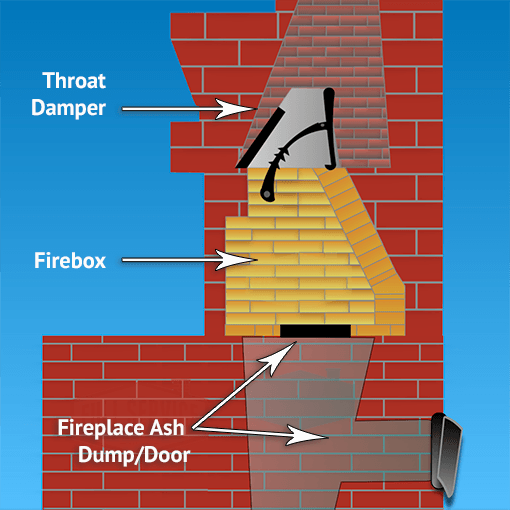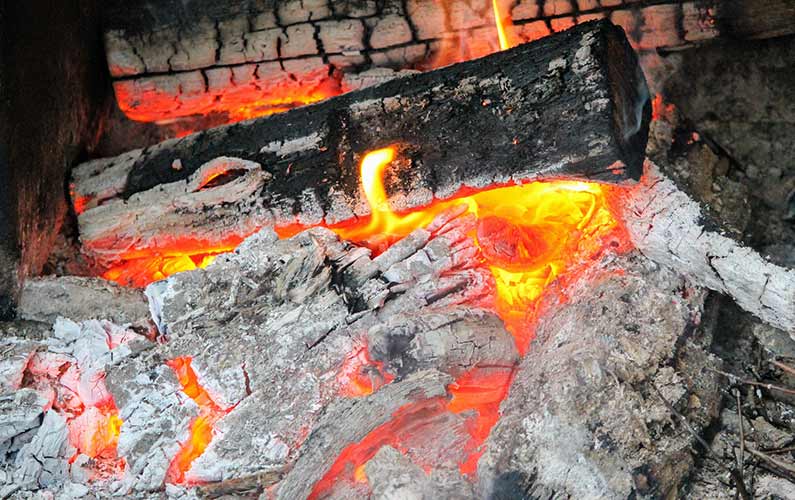The enjoyment of wood fires in the fireplace was once the only way families enjoyed their hearth during the burning season. However, wood burning not only produces a cozy time for family and friends around the hearth, it produces the messy ash that becomes more than a handful to clean up!
Most folks are well aware, that use of the fireplace means annual chimney sweeping and fireplace cleaning. This is a service that hopefully reduces the incidents of chimney fires that endanger many homes and the families who live there.
On occasion, we get a request for ash dump cleaning. This is a task that often results in a mess for anyone who tries to do it, even the professionals. We offer a smarter way!
The Smart Way to Dispose of Fireplace Wood Ash
At Full Service Chimney, ash pit service is not a cleaning, but rather repairs or system corrections that provide homeowners with easy and safe enjoyment of their fireplace without the mess and inconvenience of a wood burning fireplace. Is it your standard ash dump cleaning? No. It’s a better solution to a dirty problem.
Our solution is fireplace repairs that:
- safely modify the hearth to make ash clean up a snap.
- ensure no additional mess or embers make it to the basement level.
- should strongly be considered if you have converted to gas logs or have an insert.
- are usually accomplished in less than two hours.
Schedule your appointment today. We’ll come out and walk you through all the solutions to make Ash Dump Cleaning a thing of the past!
Standard Ash Disposal Options
To handle the ash left behind after a fire, many of the brick and mortar fireplaces in the Kansas City metro area had ash dumps built in to their chimney just below the hearth of the fireplace. The way ash was moved from the fireplace to the ash dump was done slowly with a small shovel and fireplace broom, by the homeowner.
This shoveling of the ash into a small trap door did not get rid of the ash, but rather to the holding area: a.k.a. “the ash dump” to allow people to deal with it later. It was a good idea at the time, but also problematic. The mess is temporarily out of sight, out of mind… until it’s time to clean it out.
Fire after fire, year after year, ash would go into the ash dump. The problem? Rarely would anyone take on the day-long chore of cleaning out the ash dump through its 8″ x 8″ door.
Now understand, we have the solution for this problem, but in truth we rarely offer this as an actual cleaning service, and for good reason. Of the few times we’ve tried this “ash-dump clean-out service” it has taken no less than 4 hours (frequently more) and filled the basement with ash spilling through the open door. For most people who have tried this at home, it has only happened once and they said “Nope, never again!” That’s when they call us for help. We offer cleaner fireplace solutions without the need for ash dump cleaning services.
Full Service Chimney has been the provider for Kansas City’s families for over 35 years and ash dumps are no exception. By adjusting the design of the hearth and sealing off the ash dump assembly, home owners now simply can shovel the ash only once into a fireplace ash bucket. After the conversion, cool ashes are collected into a metal ash bucket before the next fire. Voila!


Proper Fireplace Ash Disposal
When removing ash from your fireplace to dispose of it, always assume that there are live embers in the ash. People sometimes try to use paper or plastic bags for ash (as they would for other waste) however this is a dangerous mistake that could start a fire!
We’ve seen customers accidentally ignite carpets or wooden decks with hot embers in fireplace ash they didn’t know was still hot!
Take Caution When Disposing of Ashes, Even When You Think They’re Cooled Enough to Handle!
Use a metal fireplace ash bucket to dispose of your fireplace ash. Metal containers are the safest option available. It is necessary to take precautions to help prevent tip over, which could cause a fire if it was hot embers or even when cooled would undoubtedly cause a mess of ash spilling out!
IMPORTANT: You must remember to only store metal bucket ash containers OUTSIDE your home, on a non-combustible surface. For instance, a concrete patio is acceptable while a wooden deck is not.

Can Wood Ash Help My Garden?
It would be a waste to discard any natural resource that could have a benefit to our gardens. Ash from your fireplace has been known for centuries as a soil supplement that is natural in several key elements. It also saves you the issue of disposal entirely thereby also preventing the fire hazard of any careless disposal.
Here are some key tips for using wood ash in the garden:
- Since wood ash is alkaline, you should only use it in soils that need to adjust soil acidity. Consider adding wood ash if the ph is much below 6.5-7.
- Plants that need a higher acidic soil may not benefit from wood ash.
- Nutrients like potassium, calcium and magnesium are abundant in the ash left after burning hard woods.
- Give the ash to be absorbed into the soil prior to seeding or adding bedding plants.
- As with any chemical, PPE gear is a must. Eye protection will keep dust from causing irritation, gloves as well is a good idea.
- If the fireplace ash could have live embers, dampen before or right after application to speed up absorption and minimize catching your mulch on fire.
Ash Dump PRO TIPS
- Ash from the fireplace should be treated with the same care as any potentially flammable material.
- Only store in an airtight metal container with a tight fitting lid.
- The container should be stored outside on a non-combustible surface.
- The container should be far enough away from structures and combustibles that if it fell over and the lid came off, it could not threaten anything with fire.
Other Repair Options May Be Available
Every brick in a house is unique, and as such, a home with a masonry chimney and an ash dump is likely old enough to start falling into disrepair. If you or the former homeowners, were vigilant in keeping up on your inspections and flue sweeping, then fixing the ash dump in the way described above should be fairly easy and straightforward.
If you’re already a customer of Full Service Chimney, we will likely not find too many issues that hadn’t been reported and repaired in the years prior, as you know we help you every year to make sure your fireplace system stays in working order.
However, if you’re on the other side of that coin and perhaps have not kept up the regular chimney and fireplace care, then proper repairs could get more costly than you might expect, due to lack of maintenance.
Now, we don’t say that to scare anyone off, as there may be other solutions that could be much more suitable to your situation, than a fireplace cleaning for your ash pit.
We simply won’t know what’s needed until after an inspection is performed.
Summary for Ash Dump Fireplace Services in Kansas City
While we can appreciate any DIY enthusiasts, having performed this messy task ourselves in the past, we do not recommend anyone attempt an ash dump clean-out, as it may result in a much worse mess to clean-up!
As stated above, it is important to keep in mind that all masonry chimneys are unique. Each system requires slightly different solutions. Due to this fact, we cannot give advice over the phone, as it is not quite as simple as selecting a product or service from a list, and then having it performed.
Every flue system must be fully evaluated by a certified professional before determining the service that could help you most. Call (913) 642-6171 and our customer support team will help you schedule your chimney inspection.
At your appointment a Certified Chimney Sweep will visit your home and determine the complete set of options available to you based on the condition of your chimney and fireplace, and how your ash dump was constructed. During your appointment make sure to mention that Ash Pit Service is something you’re interested in learning more about. This will help the technician understand the results you want to achieve and be able to present you with the best options.
Looking forward to helping you build the fireplace you need, to live the lifestyle you want!

